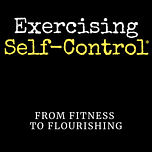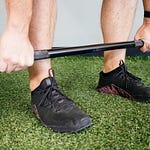You know exactly what you need to do. The presentation needs finishing. The gym membership needs using. The difficult conversation needs having. Yet somehow you don’t do it. You find yourself stuck in a familiar loop of knowing what’s right but not following through.
The problem isn’t that you’re somehow broken or otherwise unable to follow through. It’s much simpler. You’re asking yourself the wrong questions.
Hey there. It’s me, Kore. And you’re listening to Exercising Self-Control: From Fitness To Flourishing.
The Problem with “Why” Questions
Don’t ask, “Why am I not doing this? Why can’t I get myself to do this?”
If you ask this of yourself your brain will supply you with answers. They may well be factual answers. They may also be flights of fantasy. The brain will supply answers to any question it’s asked, even if it has to make something up. And depending on the question you ask it may be unhelpful.
Research in cognitive psychology shows that problem-focused questions activate neural pathways associated with rumination and self-criticism. While solution-focused questions engage creative and executive function areas of the brain.
The Power of “How” Questions
Instead of asking “Why can’t I…?” ask,
“How can I do this thing?”
or even, “How could I do this thing?”
Here you’re considering possibilities without any pressure. You’re just playing with the ideas. This will open up your creative thinking.
Now the brain will come up with answers, as well. And again these answers may not be realistic or appropriate but that’s okay. That’s how creativity works.
The SHIFT Method: A Simple Framework
Here’s a simple framework you can use called SHIFT:
S - Stop asking “Why can’t I…” questions
H - How-focused questions instead
I - Implement one solution
F - Follow-up and adjust
T - Track your progress
Photo by Leon Rockel
Putting It In Practice
Here’s how this works in practice.
Not... Why can’t I get myself to make 10 sales calls this week?
Possible answers:
I don’t want to pressure people.
I have low self esteem.
I’m afraid of criticism because my dad criticized me so much when I was young.
Instead... How can I make 10 sales calls this week?
Possible answers:
I can ensure I have a solid script that’s well practiced.
I can make 3 calls per day and finish before Friday.
I can stop putting pressure on myself to succeed with every call; just make the call and see what happens.
Not... Why can’t I eat better?
Possible answers:
I have a bad relationship with food.
I’ve never been good with eating healthy food.
I don’t believe I can stick to a healthy eating plan.
Instead... How can I eat better?
Possible answers:
I can keep eating the way I’m eating and add one apple every day as a start.
I can make sure I include 25 grams of protein with every meal to get to my daily protein intake goal.
I can order healthy prepackaged meals for breakfast and lunch and make my own supper.
Not... Why can’t I get up at 6 AM every morning?
Possible answers:
I’m so tired when the alarm goes off.
The bed is so comfortable and the room is so cold when I get up.
I have such a hard time getting to sleep at night.
Instead... How could I get up at 6 AM every morning?
Possible answers:
I’ll get to bed by 10 PM so I get at least 7 hours of sleep.
I’ll put the alarm clock across the room so I can’t just reach over and hit snooze.
I’m going to set up a 6:15 AM phone call with a friend who I know is already up for accountability.
Understanding Your Two Selves
Think of it this way: your Conditioned Self (i.e. your habits and automatized behaviours) can only do what it’s been conditioned to do by chance or by your own choice. So if you have a hard time getting up in the morning you’ve been conditioned to have a hard time doing that. Accept it. Don’t worry about why it’s happening.
What you must do differently is make choices consistent with the behaviour you want. In other words, your Choosing Self must train a new Conditioned Self, so getting up in the morning becomes the easy conditioned behaviour. And that’s a matter of discerning how to implement that training.
“How can you train yourself to get up easily in the morning?” Can you see how that makes you consider completely practical options? Instead of searching for reasons for failure, you are searching for ways to succeed. The preferred outcome becomes the focus. The achievement becomes the perspective from which you consider the circumstances.
When Your First Solution Doesn’t Work
Here’s what most people don’t tell you: your first “How” solution might not work. That’s normal and expected.
If you tried to get up at 6 AM by putting your alarm across the room but you still hit snooze and went back to bed, don’t go back to asking “Why” questions. Instead, ask: “How can I adjust this approach?”
New possibilities here might include:
Setting three alarms 5 minutes apart all across the room
Going to bed 30 minutes earlier
Having someone call you at 6:05 AM
If your healthy eating idea didn’t work as well as you’d hoped, ask: “How can I improve this approach or try a different one?”
The key is to treat each attempt as data, not as failure. You’re not broken if the first solution doesn’t work. You’re just gathering information about what adjustments are needed.
Just as you condition your body to be fitter you must condition your brain to learn a new behaviour. This takes practice. I keep stressing this word ‘practice’ for a reason. This is training not programming.
The Choice You’re Really Making
Here’s the interesting thing. If you say, “I can’t do it” you’re literally saying, “I can NOT do it.” It’s easy to NOT do something. That’s what you’ve been conditioned to do, or in this case, NOT do.
The difference is that you believe you don’t have the choice to actually do it. But if you can accept that you’re choosing to NOT do it then you open yourself to the possibility you can also choose to do it.
Your Next Step
Starting now do your best to catch yourself asking a “Why can’t I” question. Stop mid-sentence and rephrase it as a “How can I” question. Choose one answer, even if it’s imperfect, and act on it. Notice what happens. As needed, adjust and try again.
The goal isn’t to come up with the final answer on the first attempt. The goal is movement. And movement, even just the smallest amount, breaks the cycle of inaction that’s been holding you back.
So…what’s one thing you know you should do but haven’t been doing? How could you do it?
That’s it for today. Catch you next time.












